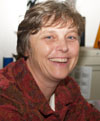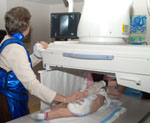Pediatric Radiology Division chief
eases patients', parents' fears
by
Mary Helen YarboroughPublic Relations
Her life is full, balanced between family, her work diagnosing sick children, and the many community projects to which she is committed.
 Dr. Jeanne Hill
Dr. Jeanne HillJeanne Hill, M.D., also approaches everything she does with a kind of cheerful intensity, and everyone she encounters with dignity and compassion.
As chief of the Pediatric Radiology Division at MUSC Children’s Hospital, Hill’s days are filled with helping to unmask mysterious reasons that make children suffer. “I find it more fulfilling working with children,” Hill said. “When you make a diagnosis in a child, you affect an entire life. Most children get better. Unlike most adults, children don’t cause illnesses in themselves.”
And she eases parents’ fears.
 Dr. Jeanne Hill
performs a fluoroscopic study on a baby.
Dr. Jeanne Hill
performs a fluoroscopic study on a baby.Hill is patient and careful to discuss with parents what she is doing and what she is finding while all are assembled in a dimly-lit radiology room observing the live scopes from a tiny body. When the lights come on, they uncloak led-protected aprons and listen to what Hill has found and what they can expect.
“I understand the fear of the unknown,” said Hill, a mother of three children, the eldest of whom is on the autism spectrum. “People can deal with it if they understand it. So, I spend more time talking to families than most.”
Unfortunately, most patients don’t get to interact with a radiologist the same way they might with their family physicians or specialists, she said. Usually, patients have to wait days to find out the diagnosis.
“I think it’s unfair to do a procedure and leave the room, and leave [patients and families] hanging for a couple of days,” Hill said. “I like talking to the parents and children. I understand what they feel, as a parent myself. I can empathize. That helps me in my relationship with the patients.” Her tools include advanced equipment, including a GE fluoroscopic machine acquired in January 2006 that Hill calls “a work horse” in pediatric radiology. While the use of noninvasive fluoroscopic procedures has decreased in adult patients due to the aggressive use of endoscopy, fluoroscopy is still commonly used in children. “Endoscopy is a high risk procedure in children requiring sedation and in some cases intubation. While adult fluoro has dried up, we operate a pulsed fluoro in children so that we limit radiation in short spurts only at the time we need to record an image. We can also take the images straight off the screen.”
Pediatric radiology also involves ample use of ultrasound. “Ultrasound is a tremendous tool. It is non-invasive, pain-free and uses no radiation. Children are ideal subjects for ultrasound, because they have very low body fat,” she said. “We do ultrasound on cases that others would use CT.”
The program also has the latest in CT scanning equipment that employs radiological dose reduction methods.
“We really try to keep the dose as low as possible,” or as low as reasonably achievable to eliminate implications of high dose radiation, Hill explained.
On a slow day, Hill will conduct about seven fluoroscopic procedures and up to 20 ultrasounds. On the average day, she will conduct 10 fluoros and 25 ultrasounds, or she will read between 100-120 plain films and four or five CT scans and MRs.
Meanwhile, Hill also is the principal investigator on a multi-center trial sponsored by the investigative arm of the American Colleges of Radiology evaluating the utility of whole body MRI in the staging of pediatric malignancies.
“The hope is that a single, relatively ... non-invasive test, whole body MRI, can replace a batter of tests including CT, MR, nuclear medicine and bone marrow biopsies that are currently used in the evaluation and staging of children diagnosed with certain types of cancer,” Hill said.
Hill’s section team includes two full-time and two part-time pediatric radiologists, and six dedicated pediatric techs and administrative staff that Hill said make her section run efficiently. “We have technologists and imagers that are specialized just for kids-they love working with children every day,” she said.
Also an educator, Hill lectures in gross anatomy and multiple continuing medical education venues, and helps supervise radiological students and residents, many of them visitors from other medical schools and residency programs, such as the University of South Carolina and schools in Georgia.
“Teaching is what I love to do,” she said. “Our Children’s Hospital is superb,” she added, referring to the popular destination for off-campus medical students. “We see a large volume and variety of pathology. And though that’s sad for kids, it’s excellent for training.”
When Hill is not working, she is coaching one of her children’s sports teams, or she’s volunteering in one of their schools. “If you’re not your child’s advocate, no one else is,” said Hill, whose part time work schedule accommodates her dedication to parenthood. “I’m very much an active mom.”
And in between work and school, she is contributing her time to advance MUSC educational and alumni interests. She is a past recipient of MUSC Radiology Department‘s Golden Apple Award, which is bestowed for teaching excellence. She has been listed in America’s Best Teachers, and the Best Doctors in America for at least three years-running.
Though she had always planned to go to medical school, Hill’s career path was at first diverted.
After college, Hill, who had a penchant for the arts, worked as a sales representative for Addison Wesley Publishing Co. in its higher education division.
“They actually offered me an assistant editor position in their Boston office,” said Hill, a Duke University English major, “but I turned it down to go back to medical school. The publishing business was interesting, but something was missing. I didn’t really feel like I was giving back or helping others.”
She also plays the piano. “One of my greatest joys is to play duets with my daughter or accompany her vocal solos. Everyone wanted me to go to graduate school, my piano teacher, the English faculty. I loved English, my college friends and premed colleagues razzed me about the arts, but as I argued then, my liberal arts education has enabled me to read, write and think.”
And she helps children heal, parents cope and inspires young and seasoned physicians to understand the best way to use radiology in the practice of medicine.
Friday, Jan. 19, 2007
Catalyst Online is published weekly,
updated
as needed and improved from time to time by the MUSC Office of Public
Relations
for the faculty, employees and students of the Medical University of
South
Carolina. Catalyst Online editor, Kim Draughn, can be reached at
792-4107
or by email, catalyst@musc.edu. Editorial copy can be submitted to
Catalyst
Online and to The Catalyst in print by fax, 792-6723, or by email to
catalyst@musc.edu. To place an ad in The Catalyst hardcopy, call Island
Publications at 849-1778, ext. 201.